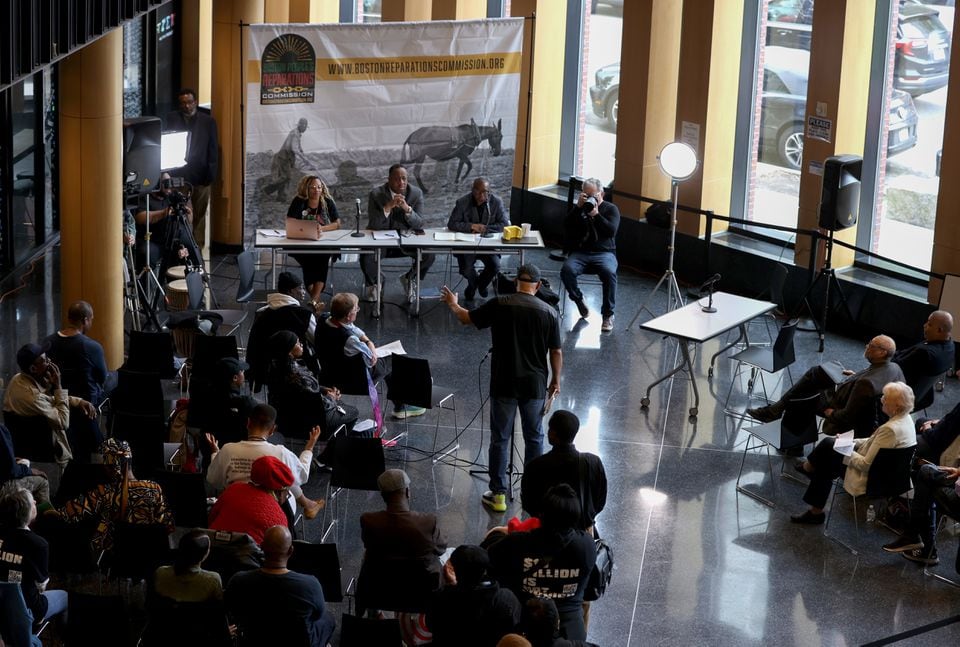When Mayor Michelle Wu tapped 10 activists, historians, scholars, and students to study Boston’s complicated relationship with slavery last year, the appointments were hailed as a crucial step in addressing the city’s strained race relations and in making amends to African American residents.
But the earliest that Black Bostonians might get to weigh in on this process will be 2025, meaning that reparations might not materialize for years to come.
Adding to a sense of stagnation are varying perspectives on what reparations could look like among members of Boston’s reparations task force, and the opaqueness of the research process that will provide data for the task force to use. There are also independent reparation efforts in Boston, separate from the city’s task force, which are happening at the same time.
“Trust me, I am on the side of urgency,” said Robin Rue Simmons, founder and executive director of FirstRepair, an Illinois-based organization promoting reparations efforts around the US. “But I’ve seen in many cities the excitement of the initial milestone and then a struggle of just trying to figure out: How do we establish the task force? Should it be a committee? Should it have a sunset? Should it be in perpetuity? Should it be five years?”
She added: “These types of things take time.”
For Boston, the methodical process is built into the task force’s guidelines, which require that its 10 members select independent researchers to study Boston’s slavery ties and, from there, use community feedback to make reparations recommendations.
The reparations task force must answer: At what point is it right for the community to weigh in, before or after the research is complete? And how much oversight should the city have in determining the right time for community engagement?
Behind closed doors, Globe reporting has shown task force members are split on what reparations should look like and who exactly should determine it. Some want to move forward only when the research is complete so that they’re equipped with vetted, solid data when creating a reparations framework for the public.
”I’m not going to have meetings to make people feel good,” said Joseph D. Feaster Jr., chair of Boston’s reparations task force. “How will they be informative to a process when I don’t even have a baseline in terms of information?”
Others want to use the intervening time to gather insight from Black Bostonians, while informing residents on what impact reparations could have on the city as a whole.
“We don’t want to wait until the research is done,” said Carrie Mays, the task force’s community engagement chair. “Community engagement will simultaneously be happening at all of these phases.”
As the task force irons out its role, independent groups in Boston have offered their own ideas on how to engage the community.
Leaders of the 70-member Boston People’s Reparations Commission, which is independent of the task force, have called for the city to deliver $15 billion — more than three times the city’s annual budget — in reparations for Black residents.
The Rev. Kevin Peterson, the commission’s founder, said it’s crucial to couple grassroots reparations organizing with the city’s ongoing research because “we can walk and chew gum at the same time.”
“We appreciate the work the task force is doing, but there’s a need to focus on pedagogy and policy,” he said. “The study doesn’t have to precede mobilization.”
In February, Embrace Boston, the nonprofit behind “The Embrace” memorial in Boston Common, released a report that broke down reparative efforts along the lines of criminal justice, education, and the arts, among other categories. The report suggests sweeping reforms to the Boston Police Department; full implementation of the Student Opportunity Act, which would dedicate more money towards low-income schools; and the development of more monuments and museums dedicated to Black history.
The city’s reparations task force has yet to issue any suggestions of its own. Feaster pointed to the original ordinance, which only equips the group with selecting researchers, making recommendations from the research, and then carrying out reparations. Anything beyond that, he said, would be out of the task force’s purview. So, they must wait.
“This is a marathon, not a sprint,” Feaster said.
Since their swearing-in last April, the task force’s process has been murky. Two of its original members stepped down due to time constraints. Its public meetings are few and have no clear schedule. The task force canceled its Monday meeting because it is “working internally on a few items to present and want to be in a better place beforehand,” according to a city spokesperson, and isn’t booked to convene until June 24.
In late March, Boston City Councilor Tania Fernandes Anderson, concerned with the task force’s level of community engagement, requested a hearing to discuss “the alignment of the Reparations Task Force process, its request for proposals, and community inclusion efforts with civil rights.” The hearing is scheduled for June 27.
In January, the reparations task force selected two research teams to study slavery’s overarching effects on Boston history: one from Tufts University to study Boston’s role in the trans-Atlantic slave trade from 1620 to 1860 and another from the Royall House and Slave Quarters in Medford to research the longlasting legacy of slavery during and after the Civil War from 1860 to 1940.
In a second team commissioned by the task force, a cohort of Northeastern University scholars is researching slavery’s longstanding legacy, in the era after 1940, through inequality within the Boston Public Schools, Boston Police Department, Boston Fire Department, and Boston Housing Authority.
The research consultants were given a December deadline to present their findings.
Ted Landsmark, director of Northeastern University’s Dukakis Center for Urban and Regional Policy, sits on the school’s research team and said it would be premature to weigh in on the work’s potential impact. At the moment, the group is only taking stock of what research has already been done, and how Northeastern can fill the gaps, he said.
“We’re really just digging in,” Landsmark said.
George “Chip” Greenidge Jr., a reparations task force member, said in a statement that city staff “has their thumb on the scale too much during our reparations proceedings,” preventing them from carrying out their work.
“We need more autonomy as an independent public body,” Greenidge said. When asked about how the task force’s autonomy has been limited by the city, he declined to elaborate.

Lori Nelson, the city’s senior adviser on racial justice, said municipal employees have been brainstorming ways they can use their resources to support the task force, while not drowning out their unique perspectives.
“Four hundred years does not take care of itself overnight,” Nelson said. “We feel that tension and urgency, but also want to ensure that we do this in a way that serves the people.”
In a text message, Fernandes Anderson said the city could consider investing in consultants that would support the task force with community engagement and conflict resolution.
Mays said she would like to coordinate more events that “meet the community where they’re at.” She is working on a “communications outreach and community engagement plan,” which suggests improving virtual and physical accessibility for meetings, providing childcare for parents who would otherwise not be able to make it, or hosting meetings in buildings with historical or cultural significance to Black Bostonians.
“This has to be an educational and intergenerational effort,” Mays said.
A lot of the process might come down to trusting and hoping that “there’s work happening behind the scenes,” Rue Simmons said, to create an outcome that Boston’s Black community will be satisfied with.
Tiana Woodard is a Report for America corps member covering Black neighborhoods. She can be reached at tiana.woodard@globe.com. Follow her @tianarochon.


